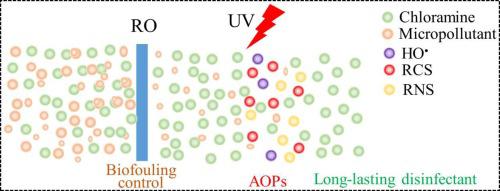Journal of Hazardous Materials ( IF 12.2 ) Pub Date : 2021-09-27 , DOI: 10.1016/j.jhazmat.2021.127341 Zhenfeng Cao 1 , Ximing Yu 2 , Yuzhen Zheng 1 , Ehsan Aghdam 3 , Bo Sun 4 , Mingming Song 5 , Aijie Wang 6 , Jinglong Han 7 , Jian Zhang 1

|
The need in using reclaimed water increased significantly to address the water shortage and its continuing quality deterioration in sustaining societal development. Degrading micropollutants in wastewater treatment plant effluents is one of the most important tasks in supplying safe drinking water, which is often achieved by full advanced treatment technologies (FATs), including reverse osmosis (RO) and the UV-based advanced oxidation process (AOP). As an emerging AOP, UV/chloramine process shows many noteworthy advantages in the scenario of potable water reuse, including membrane biological fouling control by chloramine, producing highly reactive radicals (e.g., Cl•, HO•, Cl2•–, and reactive nitrogen-containing species) to degrade the RO permeated pollutants, and acting as long-lasting disinfectant in the potable water distribution system. In addition, chloramine is often designedly produced by taking advantage of the ammonia in source. Thus, UV/chloramine processes gather much attention from researcher and published papers on UV/chloramine process have drastically increased since 2016, which were thoroughly reviewed in this paper. The fundamentals of chloramine photolysis, including the photolysis kinetics, the quantum yield, the generation and transformation of radicals and the final products, were scrutinized. Further, the impacts of reaction conditions such as pH, chloramine dosage and water matrix on the degradation of micropollutants by the UV/chloramine process are discussed. Moreover, the formation potential of disinfection by-products is debated. The opportunity of application of the UV/chloramine process in real-world practice is also presented, emphasizing the need for extensive efforts to remove currently prevalent knowledge roadblocks.
中文翻译:

紫外线/氯胺工艺在饮用水回用中减少微量污染物:综述
使用再生水的需求显着增加,以解决水资源短缺及其在维持社会发展方面的持续质量恶化。降解废水处理厂流出物中的微污染物是提供安全饮用水的最重要任务之一,这通常通过全先进处理技术 (FAT) 来实现,包括反渗透 (RO) 和基于紫外线的高级氧化工艺 (AOP) . 作为一种新兴的 AOP,UV/氯胺工艺在饮用水回用场景中显示出许多值得注意的优势,包括氯胺对膜生物污染的控制,产生高活性自由基(例如,Cl •、H2O •、Cl 2 •–和活性含氮物质)降解 RO 渗透的污染物,并在饮用水分配系统中充当长效消毒剂。此外,氯胺通常是通过利用来源中的氨来设计生产的。因此,UV/氯胺工艺受到了研究人员的广泛关注,自 2016 年以来发表的有关 UV/氯胺工艺的论文急剧增加,本文对此进行了全面回顾。研究了氯胺光解的基本原理,包括光解动力学、量子产率、自由基的产生和转化以及最终产物。此外,还讨论了反应条件(如 pH 值、氯胺用量和水基质)对 UV/氯胺工艺降解微污染物的影响。而且,消毒副产物的形成潜力存在争议。还介绍了在实际实践中应用紫外线/氯胺工艺的机会,强调需要大力消除当前普遍存在的知识障碍。











































 京公网安备 11010802027423号
京公网安备 11010802027423号